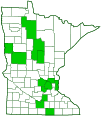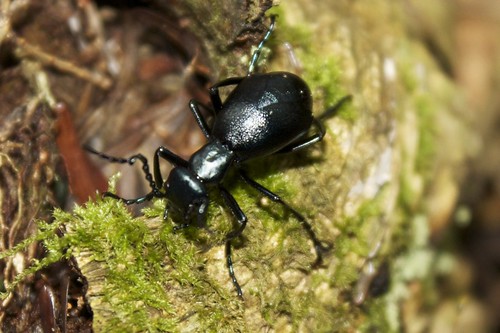buttercup oil beetle
(Meloe americanus)
Conservation • Description • Habitat • Ecology • Distribution • Taxonomy
|
|
|||||||||||||
Description |
Buttercup oil beetle, also called American oil beetle, is a small blister beetle. It occurs in the United States from Massachusetts to northern Georgia, west to Iowa and eastern Texas. It also occurs in southern Ontario Canada. It does not occur in Minnesota. The larvae live in the nests of bees and consume the food stores and sometimes the eggs that are found there. Adults are active in early spring and in late fall. They are found on the ground and on plant foliage near the ground in grasslands and at woodland edges. They feed on the leaves, flowers, pollen, and nectar of various plants, including goldenrod, buttercup, aster, and bluegrass. Adults are elongated and ¼″ to ⅝″ (7 to 17 mm) in length. The body is soft, leathery, and somewhat shiny. It may be black, bluish-black, or blue. The head is wider than long, more or less rectangular when viewed from above. It is abruptly constricted behind the eyes forming a short neck. It is sparsely covered with scattered, fine pits (punctate). The upper margin of the eye is nearly straight. The antennae are bead-like and have 11 rounded segments. On males, the antennae are bent in the middle with segments 5, 6, and 7 forming a C-shaped kink. Segment 5 is enlarged and flared outward at the end. The thorax is about as wide as long and is slightly narrower than the head. The upper plate covering the thorax (pronotum) is coarsely and deeply punctate. It is densely punctate on the rear half, much more sparsely punctate on the front half. The abdomen is oval-shaped. There are no hindwings. The hardened forewings (elytra) are small, much shorter than the abdomen, and overlap at the base. They are coarsely punctate. The legs are long and slender. The third leg segment (femur) of the front legs does not have a patch of hair. An outer spur at the end of the fourth leg segment (tibia) of the hind leg projects toward the rear. On the front and middle legs, the last part of the leg (tarsus), corresponding to the foot, has five segments. On the hind legs, the tarsi have just four segments. At the end of the tarsus on all legs there is a pair of claws. The claws are split (cleft), with equal upper and lower parts. |
Size |
Total length: ¼″ to ⅝″ (7 to 17 mm) in length |
Similar Species |
Habitat |
Grasslands and woodland edges |
Ecology |
Season |
March to May and October to November |
Behavior |
When disturbed, the beetle will emit an oily fluid from the joints. The fluid will cause blisters on human skin. |
Life Cycle |
Eggs are laid near the base of a flower. When the eggs hatch, the larvae climb to the flower and wait. When a ground-nesting bee visits the flower, one or more larvae attach themselves to the bee, which eventually carries them back to its nest. Once in the nest, the larvae feed on the eggs and stored food of the host. They pupate in the nest and later emerge as adults. |
Larva Food |
Honey, pollen, nectar, and sometimes eggs in the bee nest |
Adult Food |
Leaves, flowers, pollen, and nectar of various plants, including goldenrod, buttercup, aster, and bluegrass |
Distribution |
||
|
Sources As recently as October 2023, there were many observations of Meloe americanus in Minnesota posted on iNaturalist.org (light green on the map). In 2024(?), those observations were all moved to Meloe impressus. Now all sources agree that the range of Meloe americanus does not extend into Minnesota. |
|
| 4/18/2024 | ||
Occurrence |
||
Not in Minnesota |
||
Taxonomy |
|
Order |
Coleoptera (Beetles) |
Suborder |
Polyphaga (Water, Rove, Scarab, Long-horned, Leaf, and Snout Beetles) |
Infraorder |
Cucujiformia |
Superfamily |
Tenebrionoidea (darkling beetles and allies) |
Family |
Meloidae (blister beetles) |
Subfamily |
Meloinae |
Tribe |
Meloini |
Genus |
Meloe (oil beetles) |
Subgenus |
Meloe |
Subordinate Taxa |
|
buttercup oil beetle (Meloe americanus americanus) buttercup oil beetle (Meloe americanus occidentalis) |
|
Synonyms |
|
|
|
Common Names |
|
American oil beetle buttercup oil beetle |
|
Glossary
Elytra
The hardened or leathery forewings of beetles used to protect the fragile hindwings, which are used for flying. Singular: elytron.
Femur
On insects and arachnids, the third, largest, most robust segment of the leg, coming immediately before the tibia. On humans, the thigh bone.
Pronotum
The exoskeletal plate on the upper side of the first segment of the thorax of an insect.
Punctate
Dotted with pits (punctures), translucent sunken glands, or colored spots of pigment.
Tarsus
On insects, the last two to five subdivisions of the leg, attached to the tibia; the foot. On spiders, the last segment of the leg. Plural: tarsi.
Tibia
The fourth segment of an insect leg, after the femur and before the tarsus (foot). The fifth segment of a spider leg or palp. Plural: tibiae.
Visitor Photos |
||
Share your photo of this insect. |
||
This button not working for you? |
||
|
MinnesotaSeasons.com Photos |
||
|
||
|

Slideshows |

Visitor Videos |
||
Share your video of this insect. |
||
This button not working for you? |
||
|
Other Videos |
||
Meloe americanus (American Oil Beetle) close-up 4k 60fps |
About
Sep 22, 2023 I filmed this before I learned that these beetles excrete a dangerous poison, Cantharidin, when touched! If you see one don't pick it up, or if you need to, use gloves! |
American Oil Beetle (Meloe americanus) |
About
Oct 21, 2016 Look, but don't touch the seemingly simple and ordinary American Oil Beetle. American Oil Beetles are a type of Blister beetle. When threatened or put under pressure, they emit a chemical called cantharidin that creates blisters and irritates human skin.These particular beetles do not fly and are slow movers. |
American Oil Beetle (Meloidae: Meloe) Locomotion |
About
May 27, 2010 Photographed at the Rydell NWR, Minnesota (27 May 2010). |

Visitor Sightings |
||
Report a sighting of this insect. |
||
This button not working for you? |
||
|
|
MinnesotaSeasons.com Sightings |
||
|

Created: 10/8/2023 Last Updated: © MinnesotaSeasons.com. All rights reserved. |

